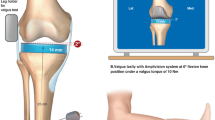Abstract
Purpose
The tibia first technique in unicompartmental knee arthroplasty (UKA) may have the advantage that surgeons can obtain a balanced flexion–extension gap. However, changes of the soft tissue tension during UKA have not been elucidated yet. The purpose of this study was to examine the correlation between the soft tissue tension before the femoral osteotomy and after the femoral component is in place using the tibia first technique in UKA.
Methods
Thirty UKAs for isolated medial compartmental osteoarthritis or idiopathic osteonecrosis were assessed. The actual values of the proximal and posterior femoral osteotomy were calculated by adding the thickness of the bone saw blades to the thickness of the bony cut. Using a UKA tensor designed to facilitate intra-operative soft tissue tension throughout the range of motion (ROM), the original gap before the femoral osteotomy, the component gap after the femoral osteotomy, and component placement were assessed under 20-lb distraction forces.
Results
The mean actual thickness of the distal femoral osteotomy was 6.5 ± 1.3 mm and the posterior femoral osteotomy was 7.4 ± 1.3 mm. The distal thickness of the prosthesis was set to 6.5 mm and the mean posterior thickness of the prosthesis used in this study was 5.8 ± 0.3 mm. There is a positive correlation between the original and component gap throughout the ROM (R > 0.5). The original and component gap showed the same kinematic pattern from full extension to 90° of knee flexion. However, the component gap was significantly higher compared to the original gap after 120° of knee flexion (P < 0.001).
Conclusions
Despite the fact that the component gap values were significantly higher compared to the original gap value in deep flexion, there is a positive correlation between the original and component gap throughout the ROM. The discrepancy during deep flexion was due to the posterior design of the prosthesis that is designed to be thinner than the actual thickness of the posterior osteotomy. These results suggest that the tibia first technique with the tensor have the advantage that surgeons can predict final soft tissue tension before femoral osteotomies with the prosthetic design and help restore natural knee kinematics, potentially improving implant survival and functional outcomes.


Similar content being viewed by others
References
Berger RA, Nedeff DD, Barden RM, Sheinkop MM, Jacobs JJ, Rosenberg AG, Galante JO (1999) Unicompartmental knee arthroplasty. Clinical experience at 6–10-year followup. Clin Orthop Relat Res 367:50–60
Riddle DL, Jiranek WA, McGlynn FJ (2008) Yearly incidence of unicompartmental knee arthroplasty in the United States. J Arthroplast 23:408–412
Brown NM, Sheth NP, Davis K, Berend ME, Lombardi AV, Berend KR, Della Valle CJ (2012) Total knee arthroplasty has higher postoperative morbidity than unicompartmental knee arthroplasty: a multicenter analysis. J Arthroplast 27:86–90
Akizuki S, Mueller JK, Horiuchi H, Matsunaga D, Shibakawa A, Komistek RD (2009) In vivo determination of kinematics for subjects having a Zimmer Unicompartmental High Flex Knee System. J Arthroplast 24:963–971
Dalury DF, Fisher DA, Adams MJ, Gonzales RA (2009) Unicompartmental knee arthroplasty compares favorably to total knee arthroplasty in the same patient. Orthopedics 32
Laurencin CT, Zelicof SB, Scott RD, Ewald FC (1991) Unicompartmental versus total knee arthroplasty in the same patient. A comparative study. Clin Orthop Relat Res 273:151–156
Mercier N, Wimsey S, Saragaglia D (2010) Long-term clinical results of the Oxford medial unicompartmental knee arthroplasty. Int Orthop 34:1137–1143
Pietschmann MF, Wohlleb L, Weber P, Schmidutz F, Ficklscherer A, Gulecyuz MF, Safi E, Niethammer TR, Jansson V, Muller PE (2013) Sports activities after medial unicompartmental knee arthroplasty Oxford III-what can we expect? Int Orthop 37:31–37
Whiteside LA (2005) Making your next unicompartmental knee arthroplasty last: three keys to success. J Arthroplast 20:2–3
Saragaglia D, Picard F, Refaie R (2012) Navigation of the tibial plateau alone appears to be sufficient in computer-assisted unicompartmental knee arthroplasty. Int Orthop 36:2479–2483
Emerson RH Jr, Head WC, Peters PC Jr (1992) Soft-tissue balance and alignment in medial unicompartmental knee arthroplasty. J Bone Joint Surg Br 74:807–810
Muratsu H, Matsumoto T, Kubo S, Maruo A, Miya H, Kurosaka M, Kuroda R (2010) Femoral component placement changes soft tissue balance in posterior-stabilized total knee arthroplasty. Clin Biomech 25:926–930
Matsumoto T, Muratsu H, Tsumura N, Mizuno K, Kuroda R, Yoshiya S, Kurosaka M (2006) Joint gap kinematics in posterior-stabilized total knee arthroplasty measured by a new tensor with the navigation system. J Biomech Eng 128:867–871
Matsumoto T, Mizuno K, Muratsu H, Tsumura N, Fukase N, Kubo S, Yoshiya S, Kurosaka M, Kuroda R (2007) Influence of intra-operative joint gap on post-operative flexion angle in osteoarthritis patients undergoing posterior-stabilized total knee arthroplasty. Knee Surg Sports Traumatol Arthrosc 15(8):1013–1018
Matsumoto T, Muratsu H, Kubo S, Matsushita T, Ishida K, Sasaki H, Oka S, Kurosaka M, Kuroda R (2012) Soft tissue balance using the tibia first gap technique with navigation system in cruciate-retaining total knee arthroplasty. Int Orthop 36:975–980
Matsumoto T, Muratsu H, Kubo S, Kuroda R, Kurosaka M (2013) Intra-operative joint gap kinematics in unicompartmental knee arthroplasty. Clin Biomech 28:29–33
Laskin RS (1978) Unicompartmental tibiofemoral resurfacing arthroplasty. J Bone Joint Surg Br 60:182–185
Murray DW, Goodfellow JW, O′Connor JJ (1998) The Oxford medial unicompartmental arthroplasty: a ten-year survival study. J Bone Joint Surg Br 80:983–989
Citak M, Dersch K, Kamath AF, Haasper C, Gehrke T, Kendoff D (2014) Common causes of failed unicompartmental knee arthroplasty: a single-centre analysis of four hundred and seventy one cases. Int Orthop 38:961–965
Author information
Authors and Affiliations
Corresponding authors
Rights and permissions
About this article
Cite this article
Takayama, K., Matsumoto, T., Muratsu, H. et al. The tibia first technique with tensor measurement is useful to predict the soft tissue tension after implantation in unicompartmental knee arthroplasty. International Orthopaedics (SICOT) 39, 667–671 (2015). https://doi.org/10.1007/s00264-014-2531-7
Received:
Accepted:
Published:
Issue Date:
DOI: https://doi.org/10.1007/s00264-014-2531-7




